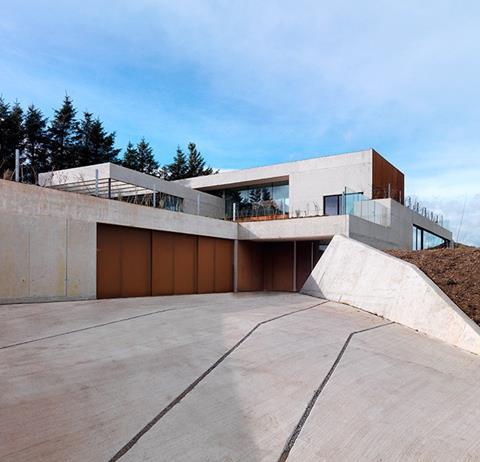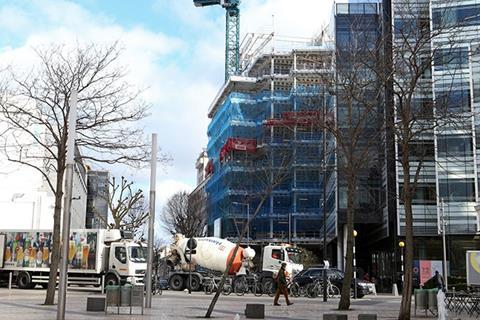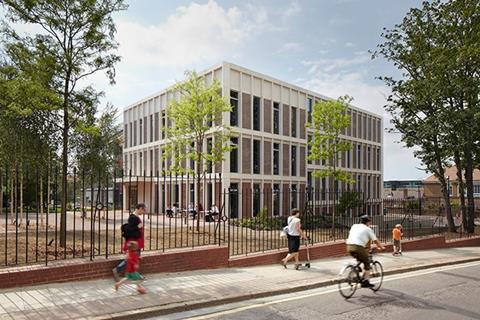Using GGBS as an additive in concrete mixes can reduce embodied carbon and improve resistance to chemical attacks. This CPD, sponsored by Hanson, outlines how it works and its various benefits

How to take this module
UBM’s CPD distance-learning programme is open to anyone seeking to develop their knowledge and skills. Each module also offers members of professional institutions an opportunity to earn between 30 and 90 minutes of credits towards their annual CPD requirement.
This article is accredited by the CPD Certification Service. To earn CPD credits, read the article and then click the link below to complete your details and answer the questions. You will receive your results instantly, and if all the questions are correctly answered, you will be able to download your CPD certificate straight away.
CPD CREDITS: 60 MINUTES
DEADLINE: 30 OCTOBER 2015


INTRODUCTION
CEM I Portland cement is a key ingredient in concrete, with a worldwide production of 1.4 billion tonnes a year. However, it is regarded as a high-emissions product: its manufacture involves burning limestone and clay together at temperatures of between 1,400°C and 1,600°C.
The use of cement replacements provides opportunities for significant reductions in energy use and carbon dioxide emissions. Ground granulated blast-furnace slag (GGBS), manufactured from a by-product of the iron-making industry, is one of the most common, and most sustainable, substitutes. The cementitious properties of blast-furnace slag were discovered in the late 19th century and it has been widely used in concrete manufacture for over 100 years.
In the UK, GGBS is usually supplied as a separate component for concrete and is added at the concrete mixer. It typically replaces 50% of the Portland cement, but up to 95% can be used in specific applications. Under the relevant British standards, GGBS is referred to as an “addition” and counts fully towards the cement content in concrete.
HOW GGBS IS MADE
Blast furnaces operate at temperatures of up to 2,000°C and are fed with a carefully controlled mixture of iron ore, coke and limestone. The iron ore converts to iron, which sinks to the bottom of the furnace. The remaining materials form a slag that floats on top of the iron. The molten iron and slag are drawn off at regular intervals from the furnace. As the slag is drawn off, its chemistry is monitored as a check on the performance of the furnace. This ensures that the chemical composition of the slag is very consistent.
After being tapped from the furnace and separated from the iron, the slag is rapidly quenched in water. This process is known as granulation because it produces glassy granules, similar in appearance to coarse sand. These have excellent cementitious properties. The granulated slag is further processed by drying and then ground to a very fine powder in a mill.
HOW GGBS WORKS
Cement acts as a binder in concrete, adhering the various ingredients and causing the mix to harden. This occurs due to a chemical reaction between cement and water, known as hydration, which produces calcium hydroxide as discrete crystals surrounded by large pores.
GGBS can be used as a replacement for cement because it contains the same oxides (see table 1) and undergoes the same hydration process. Additionally, the GGBS reacts with the excess calcium hydroxide to form calcium silicate and calcium aluminate hydrates which contribute to filling and blocking the pores within the crystalline structure. The result is a hardened cement paste, which contains greatly reduced calcium hydroxide and a refined pore structure that is less permeable. The reduction in free calcium hydroxide makes concrete chemically more stable, and the finer pore structure limits the ability of aggressive chemicals to diffuse through the concrete.
Table 1: Principal oxides
| Calcium oxide | Silicon dioxide | Aluminium oxide | Magnesium oxide | Iron (III) oxide | |
|---|---|---|---|---|---|
| GGBS 1 | 40% | 35% | 12% | 10% | 0.20% |
| Portland cement | 65% | 20% | 5% | 1% | 2% |
Table 2: Comparison of emissions (kgCO2/t)
| Portland cement | GGBS | |
|---|---|---|
| Process emissions | 640 | 0 |
| Fossil fuel use | 100 | 30 |
| Electricity use | 230 | 25 |
| Total | 970 | 55 |
| Lecture room | 35 | Average |
| Classrooms designed specifically for use by hearing-impaired students | 30 | Average |

APPEARANCE
GGBS provides a lighter-coloured finish than concrete made using Portland cement-only mixes. It has greater reflectivity, providing better visibility and therefore safety in dark environments, and reduced efflorescence. Because of the near-white colour, GGBS can be used as a replacement for white cement, with only a minimal difference in whiteness. However, for architectural applications where brightness is a critical factor, the use of white cement is recommended wherever practical.
SUSTAINABILITY
There are environmental benefits to be gained from the use of GGBS as a cement substitute, both in the production process and throughout the life of the structure. Because it is a by-product of iron-making and the slag would be created regardless of whether or not it can be used, GGBS generates very low CO2 emissions. Table 2 shows a comparison between the emissions from GGBS and Portland cement.
Producing 100m3 of concrete uses 32 tonnes of cement. Replacing 50% of that cement with GGBS saves 12.96 tonnes of CO2 – equal to taking 42 cars off the road for a year, or 41 years of electricity use in an average home.
Other sustainability benefits of GGBS include the fact that it produces very low emissions of the harmful gases sulphur dioxide and nitrogen dioxide, and that it requires virtually no quarrying or mineral extraction.
The increased durability of concrete manufactured using GGBS further improves a project’s environmental performance by reducing the amount of repair and maintenance required and extending the service life of the concrete structures.
DURABILITY
Resistance to deleterious reactions
Sulphates occur naturally in the ground and can sometimes have a harmful effect on concrete, causing it to crack and disintegrate. The main reactions are known as ettringite and thaumasite. The use of GGBS greatly increases resistance to sulphate attack due to its chemical make-up and reduced porosity. This is recognised by codes and standards: in the British standard for concrete, BS 8500, the only option recommended for the most severe sulphate exposure is a concrete with a cement replacement of at least 66% GGBS.
- Ettringite The primary sulphate reaction that causes disruption of hardened concrete is associated with one of the minor compounds in Portland cement, tricalcium aluminate. This can combine with sulphate ions that have penetrated the concrete and form a new hydrate (ettringite), which occupies a volume greater than the original constituents. This generates high internal stresses in the concrete that can cause it to crack and disintegrate.
- Thaumasite Another form of sulphate attack, called thaumasite, has been recognised as a problem after the discovery of its effects on some bridges over the M5. Thaumasite is a product that forms at temperatures below 15°C through a reaction between cement paste hydrates, carbonate and sulphate ions. Its formation reduces the cement paste to a soft mulch, undermining the concrete’s durability and stability.

Alkali-silica reaction
ASR is a reaction between the hydroxyl ions in the water within the concrete pores and certain forms of silica that are present in some aggregates. This produces a gel that absorbs pore fluid and expands, inducing internal stress of such magnitude that it causes extensive cracking of the concrete, known as map cracking. The damage occurs in parts of the concrete structure exposed to moisture. GGBS significantly reduces the risk of ASR because of its refined pore structure and because there are fewer available alkali to accelerate the reaction.
Chloride attack
Concrete can be attacked by the chloride ions found in de-icing salts, marine environments or contaminated raw materials. These damage concrete by breaking down the passive iron oxide layer that protects the steel reinforcement from humidity and oxygen. This layer is formed on the surface of the steel as a result of the high alkaline environment produced by hydrating cement.
Certain types of concrete are more vulnerable to attack because it is easier for the chloride ions to reach the steel reinforcement. When CEM I Portland cement hydrates, the resultant pores are relatively large and can easily allow chloride ions to penetrate to the heart of the concrete and attack the metal. The result is rapid corrosion of the steel, in the form of localised pitting or general corrosion.
To prevent the penetration of chloride ions, a dense concrete of very low permeability needs to be produced and this can be achieved by incorporating GGBS. Where structures are subject to attack from chlorides from an external source, a minimum of 50% GGBS should be used, with a higher proportion used in areas where high levels of chlorides will be encountered.
Heat of hydration
The hydration of cement is an exothermic reaction, which means it releases heat. The use of GGBS reduces the heat of hydration. This is significant because high temperatures in concrete can generate stresses that can result in early-age thermal cracking.
Minimising heat of hydration to reduce thermal cracking is of particular importance in mass concrete pours. GGBS was used successfully in the construction of The Shard in London, one of the UK’s largest concrete pours, at 80% replacement level.
The percentage of GGBS used directly affects the heat of hydration: a typical replacement level of 70% is recommended for large pours, according to Concrete Society Advice Note 25. A temperature reduction of up to 40% can be achieved with a 70% replacement level.

Setting times
Concrete produced with a proportion of GGBS has a slightly longer setting time than cement-only concrete. In practice, these extended setting times tend to give greater opportunity for working the concrete, and provide more flexibility on site to compensate for any delivery delays or adverse working conditions.
Concrete with a cement content containing 50% GGBS will have a setting time of approximately half an hour longer than cement-only concrete, at the same water-cement ratio and ambient temperature. Tests are recommended to ensure the correct mix ratios.
Formwork removal for sections 0.5m thick is not generally delayed by using GGBS. It is possible to shorten the time before striking formwork by insulating or heating or by determining the strength of the concrete in the element using temperature-matched curing.
STANDARDS
Key standards governing the use of GGBS in concrete include:
- BS EN 197-1:2011 Cement. Composition, specifications and conformity criteria for common cements
- BS EN 15167-2:2006 Ground granulated blast furnace slag for use in concrete, mortar and grout. Conformity evaluation
- BS EN 206:2013 Concrete. Specification, performance, production and conformity
- BS 8500-1:2015. Concrete. Complementary British Standard to BS EN 206. Method of specifying and guidance for the specifier.
BS 8500 provides notations for “within mixer” combinations containing GGBS:
- CIIS: 6-35% of GGBS
- CIIIA: 36-65% of GGBS
- CIIIB: 66-80% of GGBS.

How to take this module
UBM’s CPD distance-learning programme is open to anyone seeking to develop their knowledge and skills. Each module also offers members of professional institutions an opportunity to earn between 30 and 90 minutes of credits towards their annual CPD requirement.
This article is accredited by the CPD Certification Service. To earn CPD credits, read the article and then click the link below to complete your details and answer the questions. You will receive your results instantly, and if all the questions are correctly answered, you will be able to download your CPD certificate straight away.
CPD CREDITS: 60 MINUTES
DEADLINE: 30 OCTOBER 2015
Privacy policy
Information you supply to UBM Information Ltd may be used for publication and also to provide you with information about our products or services in the form of direct marketing by email, telephone, fax or post. Information may also be made available to third parties. UBM Information Ltd may send updates about ��ɫ����TV CPD and other relevant UBM products and services. By providing your email address you consent to being contacted by email by UBM Information Ltd or other third parties. If at any time you no longer wish to receive anything from UBM Information Ltd or to have your data made available to third parties, contact the Data Protection Coordinator, UBM Information Ltd, FREEPOST LON 15637, Tonbridge, TN9 1BR, Freephone 0800 279 0357 or email ubmidpa@ubm.com. View our full privacy policy at






















No comments yet